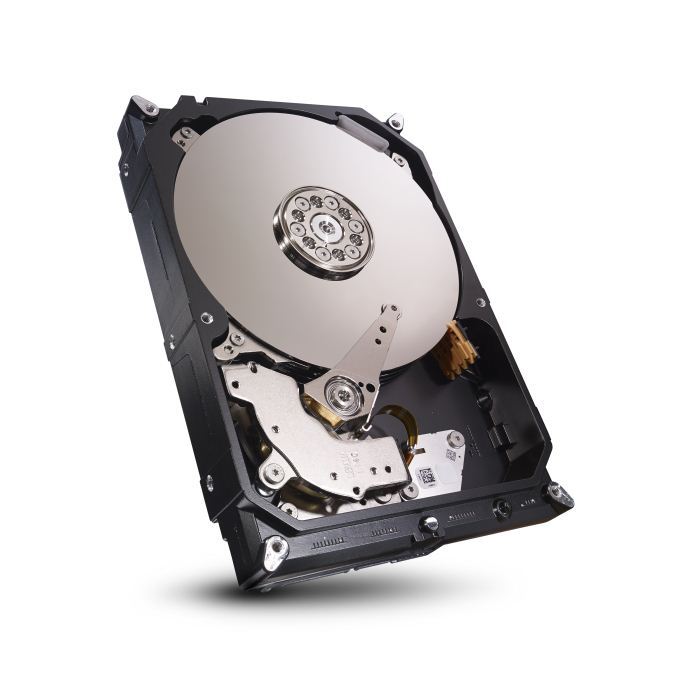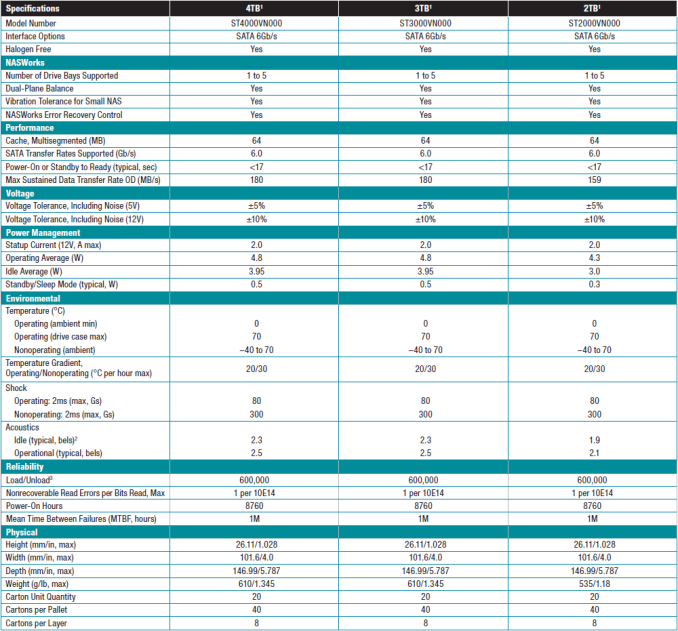Seagate Introduces NAS HDD: WD Red Gets a Competitor
by Ganesh T S on June 11, 2013 8:01 AM EST- Posted in
- NAS
- Storage
- Seagate
- Enterprise
Consumers looking to fill their SOHO / consumer NAS units with hard drives haven't had too many choices. Western Digital recognized early on that the dwindling HDD sales in the PC arena had to be made up for in the fast growing NAS segment. Towards this, they introduced the WD Red series (in 1TB, 2TB and 3TB capacities) last July. Today, Seagate is responding with their aptly named NAS HDD lineup. Just like the WD Red, these HDDs are targeted towards 1- to 5-bay NAS units. WD terms their firmware secret sauce as NASWare and Seagate's is NASWorks. NASWorks supports customized error recovery controls (TLER in other words), power management and vibration tolerance.
TLER helps to ensure that drives don't get dropped from the NAS and send the array into a rebuild phase. Seagate also claims that the firmware has an optimal balance for sequential and random performance.
Seagate does have a lead over WD in the capacity department. While the WD Red currently tops out at 3TB, Seagate's NAS HDD comes in 2 TB, 3 TB and 4 TB flavors. Seagate hasn't provided any information on the number of platters or spindle speed. Power consumption numbers are available, though. Average operating power is 4.3W for the 2TB model and 4.8W for the 3 TB and 4 TB ones.
Pricing is set at $126, $168 and $229 for the 2TB, 3TB and 4TB models respectively.
Update: Seagate has released an extensive product manual here. The 3TB and 4TB models have four platters each, while the 2TB model has two. The drives have a 3-year warranty.
Source: Seagate












46 Comments
View All Comments
joel4565 - Tuesday, June 11, 2013 - link
I wonder if they actually did anything different with the drives or if it is the same drive with just a different firmware...I am hoping to replace my Unraid server next year with a 8-10 drive FreeNAS ZFS box using Raidz2 in one of the lovely Nanoxia Deep Silence 1 cases, although I think that will only hold 8 drives as it ships.
I will have to see how these drives play out to decide if I use these or the WD Red drives. For those wondering I am probably going to switch from Unraid to FreeNAS because the speed is horrible in Unraid, especially the write speed unless you an unsecured cache drive. Unraid was quite nice at the time though because you can add capacity at any time and I didn't have the money to buy 8-10 drives all in one shot.
JDG1980 - Tuesday, June 11, 2013 - link
Good luck finding the Deep Silence 1 if you live in the US.brshoemak - Tuesday, June 11, 2013 - link
Well, if he can't pick up a DS1 he could always look at the Fractal Design Define R4 or XL R2. Actually the R4 is current $80 on NewEgg after a promo code. Seems like another good option. But all the power to you if you can your DS1.Side note, I am in the market for some non-enterprise NAS drives so this is of interest to me. I know the Reds have been around for awhile and there have been some quality issues, but there are zero points of reference for these Seagate drives. Decisions, decisions.
sherlockwing - Tuesday, June 11, 2013 - link
I would caution against buying R4 right now, that promo code signals that an R5 is due in a few month and stores are trying to clear their R4 stock. R4 debuted last year around July maybe wait a few weeks.Jumpman23 - Tuesday, June 11, 2013 - link
It's gotten to that price point before a couple of months ago. If R5 was to be out, they would've announced it at computex. Besides the R3 was made available 2 years before the R4 or so and the R4 has only been out around a year or slightly less than.brshoemak - Tuesday, June 11, 2013 - link
Well, even if they release an R5 it can't be that groundbreaking compared to an R4 and I'm sure price-wise it would start out where the R4 started ($120). I actually just checked Amazon and they have it for $80 straight-up. The R4 is well worth it for my needs regardless, but I'll look forward to seeing what they can do with the R5.Dentons - Tuesday, June 11, 2013 - link
The R3 is better than most current cases. I wouldn't worry about the R5 being much more than a facelift on the R4.3DoubleD - Tuesday, June 11, 2013 - link
Yep, Unraid can be very slow (~20MB/s writes). As you alluded to, it is truly a budget alternative though. If you have the money to spend on the better hardware, FreeNAS looks like a better option if you desire better performance. That said, it doesn't look nearly as flexible in terms of adding storage. For me, I'll probably stick with Unraid for the time being. It is fast enough for home use.joel4565 - Tuesday, June 11, 2013 - link
Speed is not the only advantage of FreeNAS. I am considering the switch because of all of the ZFS awesomeness. Things like Raidz2/3 - having multiple parity drives, build in file checksums, encryption, etc. Although the encryption that FreeNAS has is not the ZFS method since Sun/Oracle stop sharing the source for ZFS after ZFS version 28. :(I really wish ZFS would have been licensed differently so that is could be merged into the Linux kernel. Yes I know you can use ZFS with Linux, but not in a really good way.
Rick83 - Tuesday, June 11, 2013 - link
I just checked, there are kernel modules and source patches for the Linux kernel for ZFS. The only limitation that the licensing issue bring, is that you cannot distribute a ZFS patched Linux kernel.Compiling your own kernel for a NAS is quite trivial, so patching ZFS into it shouldn't be too much of an issue. The Linux implementation should be based very closely on the native one, (C code after all) with just some minor changes to adapt to different treatment of block devices. Should be much faster than FUSE, which sounds what you are describing. While still not quite as fast as the native Unix version, the delta isn't as crippling as it used to be. I think I might give it a try for my backup array, some time.